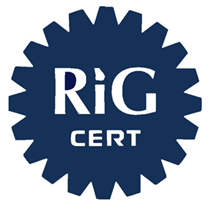Rules for the Use of the Certification Mark
RIGCERT encourages certified clients to use the certification mark for as long as their management system certification is valid and in accordance with the provisions of this document.
Certified clients may also choose not to use the certification mark.
The certification mark is provided to each certified client in electronic format following the successful completion of certification activities.
The right to use the certification mark belongs exclusively to the certified organization and cannot be transferred to any third party.
The client shall not use the certification mark or the management system certificate(s) in a manner that could bring RIGCERT, the certification system, or accreditation bodies into disrepute or result in loss of public trust.
The RIGCERT logo is a registered trademark with the EUIPO – European Union Intellectual Property Office (euipo.europa.eu).
The standard indicated on the certification mark (e.g., ISO 9001) corresponds to the management system certification held by the organization.
Certified clients may use either the colored version of the certification mark or a black-and-white version, depending on their needs.
Certified clients may display the certification mark on websites, social media, brochures, envelopes, business cards, advertising materials, and similar media.
The certification mark shall not be altered or modified. It may be resized, but proportions must be maintained and all features must remain clearly distinguishable.
The certification mark shall be displayed on the same page or area as the client’s own trademark.
It is not permitted to use the certification mark in a way that could mislead as to the originator of the communication.
The certification mark may only be used while the management system certification is valid, and only in relation to the activities and locations included in the scope of certification. If the certification scope is reduced, the use of the mark shall be adjusted accordingly.
If certification is withdrawn, the client must immediately cease all use of the certification mark.
Under no circumstances may the certification mark be affixed to a product or used in a way that suggests a product, service, or process is certified.
RIGCERT does not authorize testing or calibration laboratories to use the certification mark on their test reports or calibration certificates, as these are considered products in this context.
Certified clients may make reference to their management system certification in written statements. Such statements must be clear, unambiguous, and complete.
Examples of acceptable statements include:
-
“[Company name] holds a quality management system certified by RIGCERT according to ISO 9001.”
-
“This product was manufactured in a plant whose quality management system is certified according to ISO 9001 by RIGCERT.”
Organizations shall not use statements that are ambiguous or misleading with regard to their certification status.
The use of the certification mark and references to certification are verified during surveillance and recertification audits.
Cases of misuse must be addressed immediately by the organization. Refusal to correct misuse may result in suspension of the certification. Continued non-compliance may lead to withdrawal of the certification.
RIGCERT does not authorize certified clients to use accreditation marks or logos belonging to other organizations, such as the IAF (International Accreditation Forum) or the EA (European Accreditation).
Likewise, certified clients are not authorized to use the ISO (International Organization for Standardization) logo. Since ISO does not perform certification activities, the use of its logo by certified clients is misleading.
If certified clients reproduce certificates issued by RIGCERT, they must be reproduced in their entirety.
Clients may design and use their own logos referring to their certified management system.
For further information regarding the use of the certification mark or references to certification, clients are encouraged to contact us.
Last update: 17 September 2025


